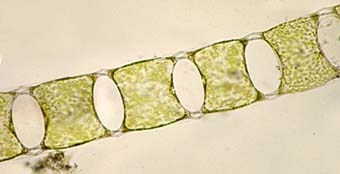
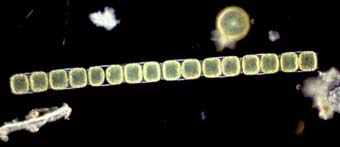
. 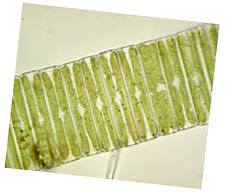
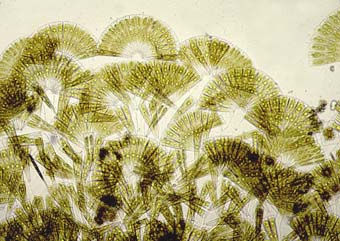
* Or diatoms have a common stalk, especially in the genus Licmophora.
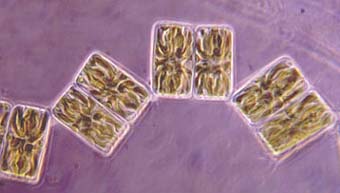
* Zig zag colonies are formed by Diatoma or Grammatophora for instance. Very special are the colonies of Bacillaria paradoxa.
Grammatophora
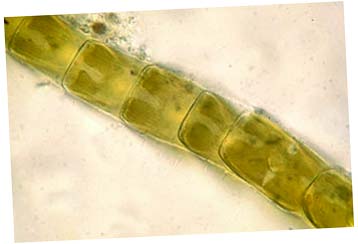
| Diatoms on strings | by Jan Parmentier |
| The study of diatoms usually starts with collecting them, followed by 'cleaning' ; removing the contents of the cells by chemical methods, in order to study the fine structure of the silica cell walls. By these procedures a lot of information is missed concerning the chloroplasts and also information about diatoms living in colonies. Diatoms are basically unicellular. However, many species use several methods to stay together. It is simplest to stay together after dividing, by means of mechanical means or by sticking together by some sort of paste. Other methods are to stay together by making a common tube or by by a string that holds the cells together. | |
| * So colonies can be formed by siliceous structures, for instance by spines. Examples are Biddulphia species. |
|
 |
* In the genus Melosira species often build long chains. |
| *
The linkage can also be obtained by mucilage pads,
probably by polysaccharide material. Band like chains
from extrodinary length are formed by Fragilaria. . |
* Or diatoms have a common stalk, especially in the genus Licmophora. |
 |
* Zig zag colonies are formed by Diatoma or Grammatophora for instance. Very special are the colonies of Bacillaria paradoxa. Grammatophora |
| * Diatoms also stay together within mucilage tubes or envelopes, with Navicula as an example. In the picture, a few specimens are gliding in a narrow tube; often the tubes are wider and contain several rows of diatoms. The colonies can have a size of several centimeters, giving the impression of a small bush and reminding one of a brown algae. |
|
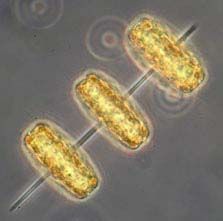 |
* And diatoms can hold together by strings or threads, possibly also strings of polysaccharides, like in Thalassiosira. |
| * In some cases diatoms are surrounded by slime masses. in which they lay in a disorderly fashion. Chaetoceros socialis |
|
| These mechanisms can be found in fresh water diatoms and in marine cells. They are so common, in planktonic and sessile or epiphytic species, that you can speculate about their survival value. It is quite possible that staying together is a defense mechanism against grazing, or in some cases (diatoms with a slime cover) to enhance also the buoyancy of planktonic species. | |
| References: 1. Friedrich Hustedt, Kieselalgen. Kosmos Verlag, Franckh-Stuttgart 1973 2. F. E. Round, R.M. Crawford, D.G. Mann, The Diatoms, Cambridge UP 1990 |
Comments to the author Jan Parmentier are welcomed. Visit Jan's HOME PAGE All Material Copyright: © Jan Parmentier Prepared for the web by Wim van Egmond
Microscopy UK Front Page
|